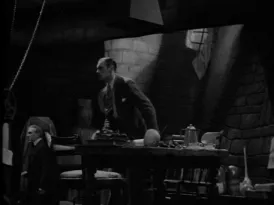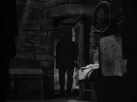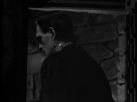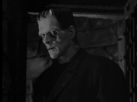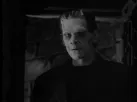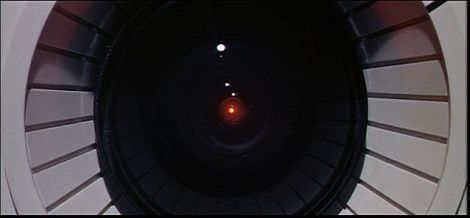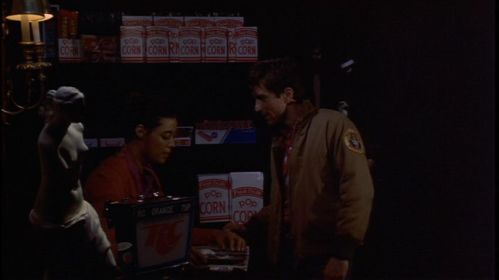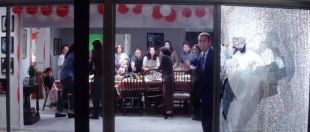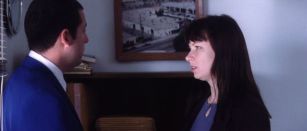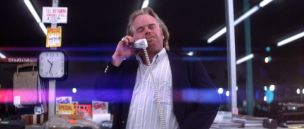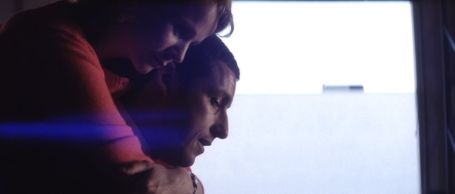By John Thurman
It seems to have been deliberately buried.
— Dr. Ralph Halvorsen (Robert Beatty) in 2001: A Space Odyssey
Buried within Stanley Kubrick’s 2001: A Space Odyssey (1968), like the monolith found beneath the moon’s surface in the film, is the motif of the Frankenstein story. In the H. A. L. 9000 computer (“HAL”), humans have created the first artificial intelligence: a sentient, albeit synthetic, life form. But HAL’s very existence is an abomination; he is a kind of Frankenstein’s monster. While perhaps not overtly monstrous, HAL’s true character is hinted at by his physical “deformity”. Like a Cyclops he relies upon a single eye, examples of which are installed throughout the ship. The eye’s literally warped wide-angle point-of-view is

HAL’s warped perspective
shown several times — notably in the drawings of hibernating astronauts (all of whom HAL will later murder). But as Frankenstein’s monster is a crudely-sutured motley of cadaverous parts obtained through grave robbing, his appearance is shocking in a way that the seemingly innocuous collection of diodes and chips comprising HAL can never be. This difference of emphasis might serve as a metaphor for Kubrick’s artistic subtlety: the placid surface must be penetrated to arrive at its deeper meaning. It will take action from HAL to make his monstrousness truly manifest. Consequently, Frankenstein’s shocking appearance, and HAL’s murders are somewhat equivalent insofar as they are revelations of character.
Indeed, Kubrick’s film equates the two. To underscore the Frankenstein connection, Kubrick nearly reproduces a scene from James Whale’s 1931 Frankenstein in both style and essential content. The scene by which Frankenstein’s monster is first shown on the loose is borrowed to depict the first murder by HAL of a member of Discovery One’s crew. In each case, it is the first time the truly odious nature of the “monster” can be recognized as such, and only appears about halfway through the film.
Kubrick took a year and a half to complete the visual effects work on 2001. (1) The scene borrowing from Frankenstein involves the exacting arrangement of various models. It is likely that the close approximation of the scene to its predecessor is a function of the careful deliberation required. A comparison of the two scenes reveals just how similar they are in terms of lighting, composition, editing, staging, and sound. To facilitate explanation, the comparison is broken into five stages.
Frankenstein shot 1

2001 shot 1
1) Frankenstein shot 1:
Dr. Frankenstein (Colin Clive) is sitting at a table talking with his mentor, Dr. Waldman (Edward Van Sloan), who warns him that his creation — using a criminal brain — may be dangerous. “Only evil can come of it . . . You have created a monster and it will destroy you,” Waldman says. Frankenstein tells him that it must be given time to develop: “So far he’s only been in complete darkness, wait till I bring him into the light.” Thus it is made explicit that the monster’s nature, previously hidden, is about to be revealed. In response to footsteps, the two doctors rise and turn to look expectantly off-screen left, to the approaching monster. Frankenstein turns off the light directly over them.
2001 shot 1:
In medium long-shot, Dave Bowman (Keir Dullea), inside the Discovery’s cockpit, shifts his gaze downward to a display of monitors before him. Off-screen Frank Poole (Gary Lockwood), his colleague, is about to emerge from the hatch of his self-contained space pod (a physical extension of HAL, effectively his “body”) to do maintenance work on the transmitter. HAL’s prediction of an imminent failure in the transmitter conflicts with the findings of his twin earthbound computer and has provoked the two crewmembers’ mistrust of HAL.


2001 shot 2
2) Frankenstein shot 2a-c:
From the scientists’ look, a cut is made to the door they are watching. It opens all the way to the right, revealing the monster backing his way in.
2001 shot 2:
An over-the-shoulder insert shows Poole emerging on the lower right of the four computer monitors, which are placed in the pod’s control console, just to the left of one of HAL’s ubiquitous eyes. Over both of the first two shots is heard the steady supply of oxygen from Poole’s respirator, as well as his heavy breathing. The hatch of Poole’s pod opens all the way to the right, and Poole emerges.

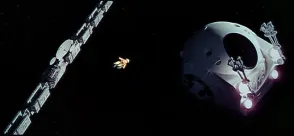
2001 shot 3a-c
Frankenstein shot 3a-d
3) Frankenstein shot 3a-d:
A medium close-up of the monster in the doorway is roughly from the two onlookers’ points-of-view. He continues to back in, then pauses and begins turning around. Reaching profile, his face is visible and comes out of shadow and into the light streaming in through a side window – just as his creator has anticipated in his dialogue. The monster continues turning, with his footsteps still sounding until he is almost fully frontal. He stops, facing forward.
2001 shot 3a-c:
A cut to the outside brings a very long shot. Poole drifts toward the ship at the left, very small in the frame. Looming menacingly in the right foreground is his empty pod. Poole continues to breathe amid the vacuum. His pod suddenly turns of its own accord, toward Poole. It is half in shadow.

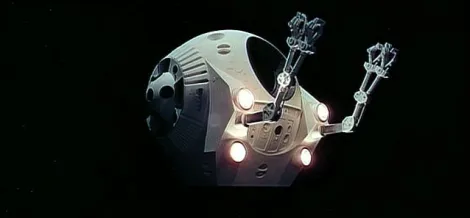

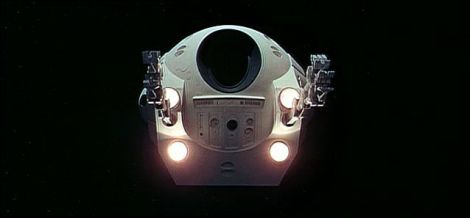

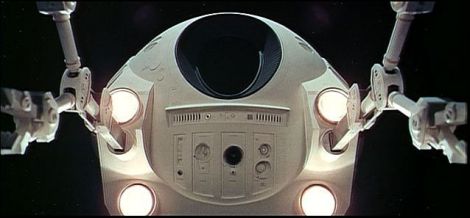
2001 shot 4a-f
2001 shot 4a-f:
The pod continues to turn around silently, as Poole’s breathing is heard. Its robot arms move, dropping down from their position of rest to extend before it while its lights flare into the camera. The pod has emerged from the shadow into the light, thus repeating the symbolism of the monster’s emergence in Frankenstein. The pod rushes forward, into the camera, opening its twin double arms with monstrous claw-like hands at their ends. HAL’s single eye can now be seen in a panel at the middle of the pod, below its portal.
Frankenstein shot 4 2001 shot 5
Frankenstein shot 5 2001 shot 6
4) Frankenstein shots 4-5:
Suddenly, a cut is made to a close-up. The sound drops out of the soundtrack entirely. Very quickly after, a cut brings an even tighter close-up, which nearly fills the frame. This is the third frontal shot of the monster in a row, and each is successively closer — seeming to rush forward shockingly at the viewer. There is still no sound. The monster’s eyes are rolled back inhumanly.
2001 shots 5-6:
A sudden cut brings a close shot of the panel, in the middle of which is HAL’s lone eye. A quick cut to the center of the panel brings the eye closer.
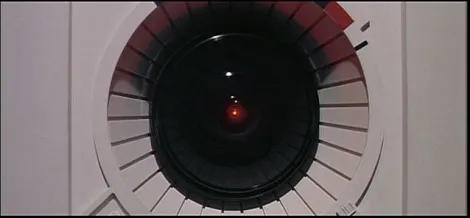
2001 shot 7
2001 shot 8
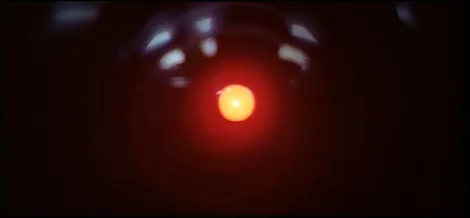
2001 shot 9
2001 shots 7-9:
A close-up fills the center of the frame with HAL’s eye. With the cut to this shot, Poole’s breathing and oxygen cut out, his breathing tube having been severed by HAL. There is absolute silence on the soundtrack. Two cuts bring closer shots of HAL’s red eye. The last of these fills the frame entirely with a mute extreme close-up, confronting the viewer with the portrait of a deep and malevolent intelligence.

Frankenstein shot 6

2001 shot 10
5) Frankenstein shot 6:
A cut is made moving back out from the oppressively close shots of the monster. This long shot repeats the setup of shot 2a-c. From the left side of the frame, Frankenstein moves to the monster and invites him in. The doctor’s footsteps, and then voice, bring sound back after the sudden dropout.
2001 shot 10:
Bowman is cut to in a medium-long shot, as he was framed in shot 1. From the absolute silence of the previous four shots, sound returns with the humming background sound of the cockpit’s interior. Bowman jerks his head to the off-screen monitor, which shows, in a later insert, Poole still alive and struggling in the vacuum of space with his severed breathing tube.
Beyond thematic concerns, the two scenes share numerous formal characteristics that make it clear one follows from the other. Both scenes begin by cutting on characters’ eyelines from a wide shot to a point-of-view or near point-of-view shot. Following this, a character emerges from behind a door, which opens all the way to the right. Then, the “monster” turns around 180 degrees to face the camera, in the process moving from darkness into light for a revelation at once literal and symbolic. During these shots, the soundtrack suddenly goes completely silent. Finally, the scene ends with a cut back to an earlier, much wider, setup as if to give breathing room after the barrage of ever-tighter close-ups.
But there is more to the Frankenstein myth as adapted by Kubrick’s film than hints at HAL’s nature and the borrowing from Whale. Like a palimpsest the story of Frankenstein also reveals inherited creation stories itself. Mary Shelley’s original novel, the inspiration for Whale’s loosely-adapted film, is subtitled The Modern Prometheus. Prometheus the Titan created man out of clay and — if the myth is not to be taken literally — in stealing fire from the Gods thereby endowed man with the divine spark of wisdom. In 2001, the monolith imparts a divine spark precipitating humanity’s evolution to a new stage with each of its appearances. Thus toolmaking is discovered. Later, a mission to Jupiter — not just a place, but the Roman name for the supreme deity whom the Greeks called Zeus, and who dwells “beyond the infinite” — is conceived. The mission is guided by a signal emanating from the monolith excavated on the moon, and executed through the use of a stargate by which time and space are transcended. Out of this meeting with God comes the further evolution to the “Star-Child.” These examples of the use of a divine spark notwithstanding, the place of Prometheus in the film is taken by humans, who create HAL and then endow him through programming. This “birth” of machine intelligence is poignantly recalled as HAL is lobotomized, when he sings the song Daisy Bell, taught him by his “instructor”, Mr. Langley. Like the Titan, humans create and endow intelligent life but suffer for it. HAL would not have had to have been incapacitated were this not the case.
The Biblical Genesis is also recalled, wherein God creates Adam from dust “in His image”. Separating human from beast is a self- awareness and the need for self-control derived from it. Thus, humans exist in God’s moral universe, and are subject to His law. HAL is likewise fashioned after his creator, being able to “reproduce . . . most of the activities of the human brain and with incalculably greater speed and accuracy.” In Genesis, humans’ resemblance to their creator implies a privileged position – indeed they are “the pinnacle of creation”. (2) They are to lord it over all the other species on Earth:
God blessed them, and God said to them, ‘Be fruitful and multiply, and fill the earth and subdue it; and have dominion over the fish of the sea and over the birds of the air and over every living thing that moves upon the earth.’(3)
HAL is privileged in that he is trusted with maintaining the crew. His function on the ship’s mission is as the “brain and the central nervous system of the ship” (so it is no coincidence that the ship encasing HAL resembles a head and spinal column – he is one modern incarnation of the first bone/tool). But just as in Whale’s film where Frankenstein’s monster was given a dysfunctional brain, HAL makes a prediction that runs counter to its earthbound twin, and thus seems to be in error. Already in the film, repeated mention has been made of the completely perfect operational record of the HAL-9000 line of computers. Bowman and Poole investigate HAL’s prediction outside the ship, culminating in HAL’s murder of Poole. Soon afterward, the three hibernating members of the crew are also murdered, during which an extreme close-up of a warning light flashes “Computer Malfunction.” It would seem that at least within the context of HAL’s mission, he too is a dysfunctional brain. This is, perhaps, inextricable from his lack of concern with morality.
These stories are united in that they are all cautionary tales of the consequences of a monumental presumption by humans, one which is an affront to God. The story of Frankenstein is a fitting successor to the earlier accounts. It is a secularization of the creation myth, a new myth for the new scientific age. George Levine notes, “the whole narrative of Frankenstein is acted out in the absence of God.” (4) Therefore, Shelley’s novel anticipates the moral vacuum later described by Nietzsche. In the wake of scientific advances that called into question numerous traditional Christian beliefs, Nietzsche declared, in Thus Spoke Zarathustra, that “God is Dead” – that is to say the Christian worldview was no longer adequate for explaining the world and infusing it with purpose. (5) Doubt had replaced faith. But Nietzsche was attempting to overcome this nihilism with an affirmative philosophy of his own, a project he called the “revaluation of all values”. Many have interpreted 2001 as an illustration of Nietzschean ideas. Don Daniels conceives of the film, at least in part, as exemplifying the three-fold evolution Nietzsche details in Thus Spoke Zarathustra: from ape to man, and finally to Bowman’s transfiguration into the ubermensch. (6) This is further emphasized in the film by using Richard Strauss’ symphonic poem, also entitled Thus Spoke Zarathustra, three times. (7) In replacing God with humanity, Nietzsche allows for the amoral hubris of Dr. Frankenstein. In Whale’s film, as Dr. Frankenstein animates his cadaverous creation, he shouts “It’s alive! In the name of God! Now I know what it feels like to be God!”
Dr. Frankenstein’s fundamental assumption is that there is nothing inherently special about life itself; it is merely a mechanism whose workings could (and therefore should) be uncovered. (8.) Electricity takes the place of the “divine spark” of Prometheus, and this is inherited by HAL. But time and death cannot be transcended through matter alone (9) and the Frankenstein story becomes a “parable of the necessity of limits in an entirely secular world”. (10) As the presenter says in Frankenstein’s prologue, the story is of “a man of science, who sought to create a man after his own image without reckoning upon God.” The same attitude is echoed by the creation of HAL. With each, humans have trespassed into the realm of the divine. In a moral universe, the inevitable result is catastrophic.
Kubrick, speaking of 2001, says “the God concept is at the heart of this film.” Kubrick then describes the vastness and age of the universe, the chemical inevitability of the development of life under certain conditions, and the
tremendous technological strides made by humans in only six thousand years of civilization. This, to him, probabilistically implies “that the universe is seething with advanced forms of intelligent life.” He continues:
At a time when man’s distant evolutionary ancestors were just crawling out of the primordial ooze, there must have been
civilizations in the universe sending out starships to explore the farthest reaches of the cosmos and conquering all the secrets of nature. Such cosmic intelligences, growing in knowledge over the aeons, would be as far removed from man as we are from the ants. . . Once you begin discussing such possibilities, you realize that the religious implications are inevitable, because all the essential attributes of such extraterrestrial intelligences are the attributes we give to God. What we’re really dealing with here is, in fact, a scientific definition of God. And if these beings of pure intelligence ever did interfere in the affairs of man, we could only understand it in terms of God or magic, so far removed would their powers be from our understanding. (11)
In the film, this divine intelligence does intervene in human affairs, to speed our evolution. It acts at least partly through technological means by leaving an artifact (the monolith) whenever doing so. The necessity of this intervention implies limits that would seem to proscribe human ability to duplicate the feat. But, it has not prevented the attempt. HAL is the apotheosis of human technology — whereby intelligent life itself is artificially evolved.
Human toolmaking is, however, through all history (and pre-history) fraught with a basic dualism. Utilitarian inventors do not trouble themselves with questions of good and evil, only the practicability of their discoveries. The same bone that allows the starving man-apes to hunt and prosper becomes an instrument of lethal inter-group warfare. After what is apparently the very first murder, it is tossed triumphantly into the air. Although four million years are spanned by the famous cut from the flying bone to the orbiting satellite, little has changed. (12) Some satellites allow Dr. Floyd (William Sylvester) to converse via “picturephone” with his daughter, or a BBC newscaster to interview the Discovery crew. The satellite that appears after the bone, though, is an orbiting nuclear weapons platform. (13) HAL is designed to aid humans, but could conceivably supplant them. Indeed he attempts to do so through intentional mismanagement of the crew’s life-support systems.
Kubrick’s universe ultimately proves to have a moral dimension, but one that seems to operate independently of God. For his rebellion against Zeus, Prometheus was chained to a rock to have an eagle feast daily on his continually regenerating liver. Likewise, for Adam and Eve’s rebellion against God they are exiled from Eden and condemned to eventually die. In Kubrick’s film it is apparently not the divine intelligence seen operating elsewhere in human history who effects retribution for the abominable presumption embodied by HAL. In this secularized myth, adapted from Frankenstein, it is the creation himself who takes revenge. Everyone in the crew but Bowman is condemned. HAL is an evolutionary dead-end, but as the incarnation of monstrous human potentialities, he must be overcome before Bowman may continue to Jupiter and a more affirmative new stage in human evolution.
Endnotes
1. Stanley Kubrick, quoted in Joseph Gelmis (Ed.), The Film Director as Superstar
(GardenCity, New York: Doubleday, 1970), p. 295.
2. Nahum Sarna, Understanding Genesis: The Heritage of Biblical Israel
(New York: Schocken. 1970) [Melton Research Center of the Jewish Theological
Seminary of America, 1966], p.14.
3. Genesis 1:28 in Michael D. Coogan (Ed.), The New Oxford Annotated Bible with the Apocrypha, 3rd edition NSRV, College Edition, (New York: Oxford University Press, 2001), p. 12.
4. George Levine, “The Ambiguous Heritage of Frankenstein” in George Levine and U. C. Knoepflmacher (Eds) The Endurance of Frankenstein: Essays on Mary Shelley’s Novel (Berkeley: University of California Press, 1979), p. 7.
5. Friedrich Nietzsche, Thus Spoke Zarathustra, Walter Kaufmann (trans.), (New York: Penguin Books,1978.) [Viking Press, 1954], p. 12.
6. Don Daniels, “A Skeleton Key to 2001”, Sight and Sound. Winter 1970/1971, p. 29.
7. Daniels, p. 33.
8. Levine, p. 27.
9. Levine, p. 6.
10. Levine, p. 12.
11. Quoted in Gelmis, p. 305.
12. Jerome Agel, (Ed.) The Making of Kubrick’s 2001 (New York: Signet, 1970), p. 76.
Although it is explicitly stated in the film that the lunar obelisk was placed four million years ago, there is no dating of the obelisk which appears during the Dawn of Man sequence. Agel specifies the same date as for that on the moon. Also, although not credited, Daniels (p.28.) notes that Kubrick cooperated with Agel in editing the book, which was issued with the film’s re-release.
13. Agel, p. 88.

